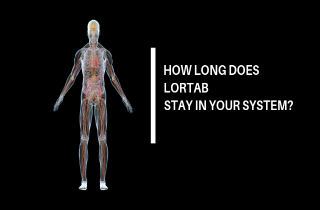MAIN POINTS: Lortab is detectable in blood for 24 hours after use, in urine 6-24 hours after use, and in hair for 90 days or longer. In fact, Lortab is most likely to be found on a drug test or opiate screen if you’ve taken Lortab within the last 24 hours. After that, the amounts of metabolites in blood and urine are low enough that many labs won’t pick up on them.
TABLE OF CONTENTS
- Taking Lortab
- Peak Levels and Half-Life
- Blood Sample Tests
- Hair Sample Tests
- Urine Sample Tests
- At Home Tests
- Signs of a Problem
Taking Lortab
Lortab is a tablet containing the narcotic pain medication hydrocodone and the over-the-counter painkiller acetaminophen. According to this 2014 SAMHSA Slide Show on Hydrocodone and Oxycodone Drug Testing, hydrocodone with acetaminophen, is the most frequently prescribed opioid drug in the U.S. Why do most people take it?
The main uses of Lortab include treating moderate to severe pain. In fact, its main active ingredient is hydrocodone. Hydrocodone is considered an opioid, or a made made, synthetic opiate. As an opioid, Lortab works by affecting the central nervous system and changes the way the body and brain respond to pain. But it comes with significant side effects.
Lortab can also cause feelings of euphoria, which are habit forming. This means that many people develop either a physical or psychological dependent on the drug which can lead to addiction. Risk of addiction increases when people take Lortab to get high. Because abuse of Lortab results in addiction, doctors screen the presence and levels of hydrocodone in routine drug tests.
Lortab is intended to be taken orally, but some people crush and snort the pill for illicit purposes. Other people may take Lortab in combination with alcohol, which can be extremely dangerous and raises the risk of serious adverse effects, including coma or death. If you are regularly getting high on Lortabs, this use can be detected. In fact, heavy or chronic use Lortab can be detected for longer periods of time.
Peak Levels and Half life
Still, Lortab is metabolized fairly quickly in the body. This is why it’s difficult to detect Lortab in someone who isn’t a heavy or habitual user, especially after more than 24 hours. However, some methods of testing such as hair sample drug screens can identify Lortab use for up to 3 months after last dose. Still, the more common blood toxicology or urine drug screens for Lortab have a very short detection period.
Want to learn more?
This 2015 SAMHSA slide show outlines precise guidelines on hydrocodone cut-off and metabolite limits.
Blood Sample Tests
Hair Sample Tests
Urine Sample Tests
At Home Tests
Administering drug tests on your own at home has become fairly accurate. Indeed, many over-the-counter tests you find in pharmacies are sensitive to the presence of drugs in urine. This means that if drugs are present, you’ll see a preliminary positive test result. Still, you should save a part of the urine sample and put it on the side to send to a laboratory for a second test.
It is very important to send any at-home urine sample to a diagnostic laboratory to confirm a positive at-home result because certain foods, food supplements, beverages, or medicines can affect the results. Laboratory tests are the most reliable way to confirm drugs of abuse like hydrocodone. In fact, many things can affect the accuracy of an at home test, including but not limited to:
- drug interactions
- food or drinks consumed before the test
- the way you did the test
- the way you stored the test or urine
Signs of a Problem
Like all opiate medications, Lortab is addictive. Lortab addiction occurs when you cannot stop taking Lortab, even if it is no longer in your body. Mental obsession and craving Lortab occur, even in spite of negative life consequences. Lortab addiction is especially risk because Lortab contains acetaminophen. So habitual Lortab abuse can cause serious liver damage or even liver failure.
How can you identify an addiction to painkiller drugs? Main signs of a problem with Lortab include:
- Continuing to use Lortab, even after negative consequences to health, home, or work.
- Craving the drug or thinking about it obsessively.
- Loss on control of drug use (amount, frequency, or administration).
- Needing Lortab to function normally.
If you’re a patient with a Lortab prescription and you’re having to take large doses for pain relief, speak to your doctor about adjusting your dosage or trying a different medication. If you’ve developed a dependence on the drug, but want to quit, your doctor can help you slowly wean yourself from the drug. Or if you think that you’re addicted to narcotics, there are support groups and medical treatments available to help. Again, your family doctor can help refer you to addiction treatment services in your area.
Now, your questions
We’ve taken a basic look at how Lortab is metabolized and how it stays in the body. We’ve also reviewed the detection window for Lortab using different types of drug screens. Finally, we invite your questions about Lortab use here. Do you still have questions about the length of time Lortab stays in your system? Please leave your Lortab questions here. We do our best to answer all legitimate questions with a personal and prompt reply.










Related Posts